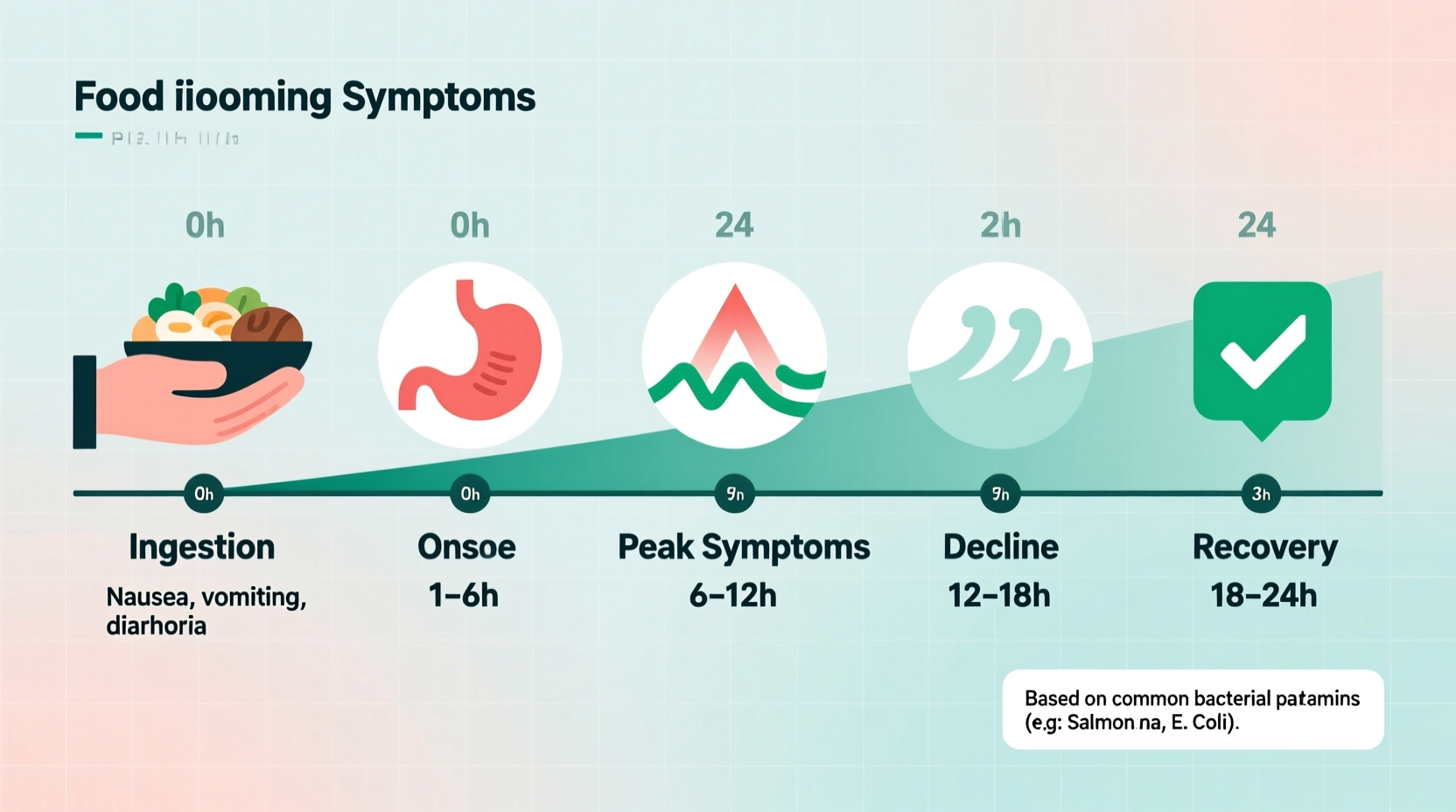Understanding the timeline for food poisoning symptoms is crucial for proper response and treatment. The incubation period—the time between consuming contaminated food and experiencing symptoms—varies significantly based on the type of pathogen, the amount ingested, and individual health factors.
How Quickly Can Food Poisoning Symptoms Appear?
Foodborne illnesses don't follow a single timeline. Different pathogens have distinct incubation periods that determine when you might start feeling ill after eating contaminated food. Recognizing these patterns helps determine whether your symptoms might be food-related and when to seek medical attention.
| Timeframe | Common Pathogens | Typical Symptoms | Common Food Sources |
|---|---|---|---|
| 30 min - 6 hours | Staphylococcus aureus, Bacillus cereus (emetic form) | Severe nausea, vomiting | Meat, poultry, dairy, rice dishes |
| 6 - 24 hours | Salmonella, E. coli, Campylobacter | Diarrhea, abdominal cramps, fever | Raw eggs, undercooked meat, contaminated produce |
| 1 - 3 days | Norovirus, Shigella | Watery diarrhea, stomach cramps, nausea | Ready-to-eat foods, shellfish, contaminated water |
| 3+ days to weeks | Listeria, Hepatitis A | Flu-like symptoms, jaundice (Hep A) | Deli meats, soft cheeses, raw shellfish |
Immediate Response: What to Do Right After Eating Suspect Food
If you realize you've consumed potentially contaminated food, your immediate actions matter. The Centers for Disease Control and Prevention (CDC) advises against trying to induce vomiting unless specifically instructed by a healthcare professional. Instead:
- Stop eating the suspect food immediately
- Preserve a sample if possible for testing
- Note the time you ate the food and what you consumed
- Stay hydrated with small sips of clear fluids
- Monitor for early symptoms like nausea or stomach discomfort
During this critical window, your body is beginning to process the contaminants. The FDA emphasizes that most food poisoning cases resolve without medical intervention, but knowing what to watch for can prevent complications.
6-24 Hours After Eating: When Most Symptoms Begin
This is the most common timeframe when food poisoning symptoms appear. According to data from the World Health Organization, approximately 70% of foodborne illnesses show symptoms within this window. During these hours:
- Salmonella infections typically cause diarrhea, fever, and abdominal cramps
- E. coli often presents with severe stomach cramps and bloody diarrhea
- Most viral foodborne illnesses like norovirus cause sudden onset vomiting
Proper hydration becomes critical during this phase. The National Institutes of Health recommends oral rehydration solutions over plain water to maintain electrolyte balance as your body loses fluids through vomiting or diarrhea.

Delayed Onset Food Poisoning: When Symptoms Take Days or Weeks
Certain pathogens have longer incubation periods that might catch you by surprise. Listeria monocytogenes, which affects vulnerable populations more severely, can take up to 70 days to show symptoms according to CDC surveillance data. Hepatitis A virus may take 15-50 days before symptoms appear.
If you experience symptoms weeks after a meal, especially if you're pregnant, elderly, or immunocompromised, mention all recent food consumption to your healthcare provider. The extended incubation period for these pathogens often leads to delayed diagnosis because people don't connect their illness to food consumed weeks earlier.
Factors That Influence Food Poisoning Timeline
Several variables affect how quickly symptoms develop after eating contaminated food:
- Pathogen type: Bacterial toxins often act faster than live bacteria
- Amount consumed: Larger quantities of contaminants may shorten incubation
- Individual health: People with weakened immune systems may show symptoms sooner
- Food matrix: Fatty foods can slow gastric emptying, potentially delaying symptoms
- Stomach acidity: Medications that reduce stomach acid may increase susceptibility
Research published in the Journal of Food Protection shows that stomach pH significantly affects how quickly pathogens reach the intestines and begin causing symptoms. This explains why people taking antacids or proton pump inhibitors may experience more severe foodborne illness.
When to Seek Medical Attention for Food Poisoning
Most food poisoning cases resolve within 1-3 days with home care. However, certain warning signs require immediate medical evaluation:
- Symptoms lasting more than 3 days without improvement
- Signs of severe dehydration (dizziness, minimal urination, dry mouth)
- Blood in vomit or stool
- High fever (over 101.5°F or 38.6°C)
- Numbness, tingling, or vision changes (possible botulism)
The American College of Gastroenterology emphasizes that vulnerable populations—including infants, elderly individuals, pregnant women, and those with chronic illnesses—should seek medical advice sooner rather than later when experiencing food poisoning symptoms.
Preventing Food Poisoning: Practical Safety Measures
Understanding food poisoning timelines helps, but prevention remains your best defense. Implement these evidence-based food safety practices:
- Follow the "2-hour rule": Refrigerate perishables within 2 hours (1 hour if temperature exceeds 90°F/32°C)
- Cook meats to proper internal temperatures (165°F/74°C for poultry)
- Wash hands thoroughly before handling food and after touching raw meat
- Use separate cutting boards for raw meats and produce
- Thaw frozen foods in the refrigerator, not on the counter
According to FDA Food Code guidelines, proper temperature control during food preparation and storage prevents the growth of most foodborne pathogens. When in doubt about food safety, remember the adage: "When you doubt, throw it out."











 浙公网安备
33010002000092号
浙公网安备
33010002000092号 浙B2-20120091-4
浙B2-20120091-4